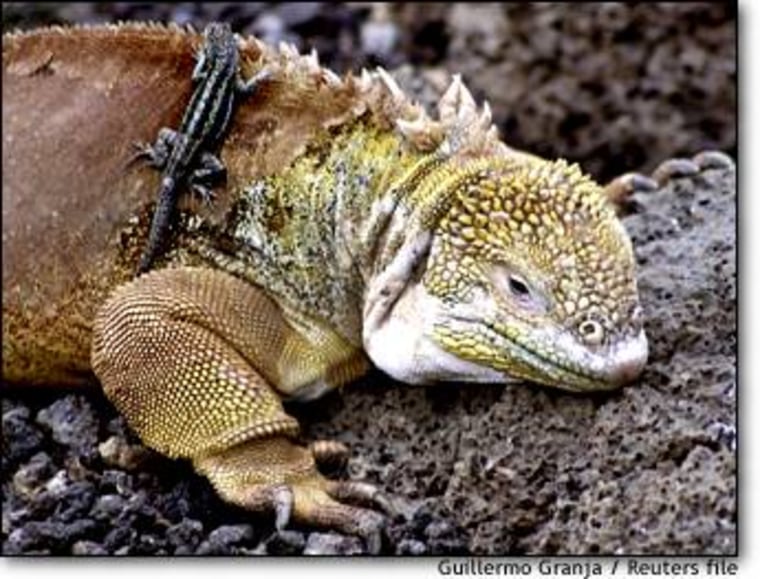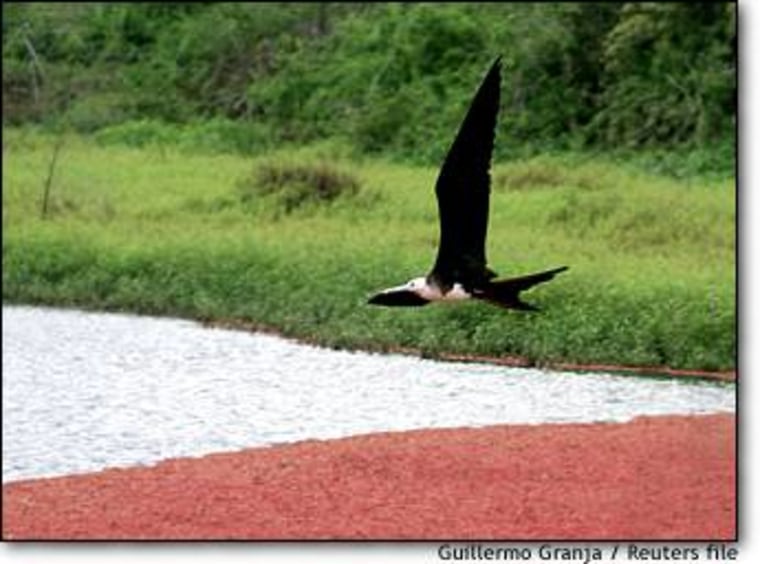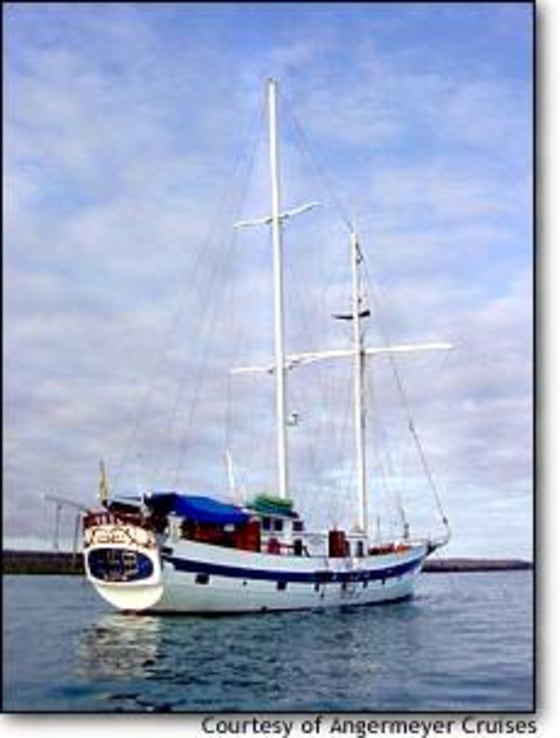Our motored dinghy sped past its intended target, a snorkel spot at a submerged volcano off the rugged island of Floreana in the Galapagos Islands.
SCRUNCHED IN WET suits, we were in hot pursuit of a whale spout, a narrow spray of ocean water shooting out of the dark blue waves. We couldn’t see the whale, but we knew from the spout that it had to be out there somewhere.
We were packed tightly in the little rubber-sided boat — 11 cruise passengers, a naturalist guide and a sailor. As we desperately tried to pick up speed, we clutched our swim masks to our faces to protect our eyes from the spray of the bouncing seas.
“There, over there,” someone shouted, and the dinghy swung to the right, following the elusive whale out to sea.
We spent eight days together in those waters, strangers on a 112-foot brigantine schooner touring the Galapagos Islands, 600 miles off the coast of Ecuador. Every night, before the boat pitched and rocked us to sleep — or to sleeplessness — we were stuck with only one another for company, take it or leave it, and leave it would have been a long swim home.
And yet the afternoon we returned to the mainland after the cruise ended, we hatched a plan to meet in a bar later that night in the capital city of Quito. A few hours later we were back together, drinking English beers and listening to Julia, a 30-year-old graphic designer from San Francisco, recount the telephone conversation she’d had with her sister earlier that evening.
Julia had tried to describe the dolphins we had seen two nights before, as our boat, the Diamante, sailed to the equator. Thousands of slick bodies leapt around us, following the setting sun into the orange glow of the horizon. Our vessel cut through their path, a graceful, purposeful dance of jumping and diving. It was an amazing sight, dolphins as far and as wide as we could see.
“My sister just didn’t believe me,” Julia told us. “She couldn’t imagine it. She said there must have only been hundreds.”
But there had been thousands, and our whole day, the Day of the Dolphins, had been like that, defying our collective imagination.
That morning we had stumbled across a giant tortoise on the west coast of Isabella Island. Flat on my stomach in the hot sand, I had watched breathlessly as the tortoise — five times my size in weight — moved toward me, coming so close I could almost smell its breath. Snap. I took its picture. It didn’t even flinch, its long neck stretched toward a black lava rock like a submarine periscope. Later we snorkeled off the beach, swimming with penguins and dodging pelicans and blue-footed boobies who were dive-bombing for their fish breakfast.
Back on the boat, we decided to jump ship, literally, dropping into the water from the bow. We fell like dominoes, Homo sapiens in various stages of flight. The water came cold and hard, filling our nostrils with the sea. We jumped in again and again.
In the afternoon, we were off to Fernandina, one of the least-visited islands in the Galapagos. Black marine iguanas, the largest colony in the islands, covered the rocks like drunken ants on an urban sidewalk, appearing everywhere and yet going nowhere, their faces turned to the sun to warm their bodies. And that evening, as we set sail for Santiago, the dolphins escorted us into dusk.
Our experience in the Galapagos had given us the ability to conjure a scene, a scent, a feeling, with one word. “The penguins,” someone would say, and it was all that needed to be uttered. Then, we were back again in the waters off a black sand beach, watching the penguins swim within inches of our masks. There was no need for clarification, no need to express with certainty that we had seen what we had seen.
In the dark pub in Quito, with the Ecuadorian soccer team playing a futile match with Brazil on the television, we had one more night together to share the magic of the Galapagos Islands. And then, we would need to figure out how to tell the story to everyone else.
THE ISLANDS
The Galapagos Islands are a remote collection of 13 major and 17 smaller islands covering 3,100 square miles in the Pacific Ocean. As all the best discoveries tend to happen, a Spanish explorer came upon the islands by accident in 1535, when a wayward current led him there. Subsequent explorers aptly dubbed the chain of volcanic formations the Enchanted Islands for their pristine beauty and strange allure. But the name Galapagos comes from one of its most famous inhabitants, the giant tortoises — Galapagos in Spanish.
During the late 1600s, the Galapagos became a base for English pirates who attacked Spanish ships returning to Europe from the New World. Whalers replaced the pirates in the 1700s and 1800s.
Ecuador claimed the islands in 1832, and in 1833 granted a Frenchman permission to establish the first settlement in the Galapagos on the island of Floreana. European and American settlers began arriving in the early 1900s, captivated by William Beebe’s 1924 book, “Galapagos: World’s End.”
The islands still have that world-end feel. They are not easy to reach, or cheap. Visitors must first fly to the Ecuadorian mainland, then catch a flight to one of two islands with an airstrip. The flights to the islands are heavily regulated, and foreigners pay about $400 for a round trip. Visitors also must pony up a $100 entrance fee, in cash, once they land on the islands. Add to that the cost of the cruise — anywhere from $800 to more than $4,000, depending on the boat, time of year and length of voyage.
Is it worth it? Many times over. This is the adventure of a lifetime.
You cannot help but be taken in by the raw images of nature pulsating in the soaring flight of the frigate bird, the courtship dance of the waved albatross, the playful dips of sea lion pups greeting you underwater for a swim, in their territory, not yours. Your territory has fences and bars.

Think of the Galapagos Islands as a giant open-air zoo in which the animals invite you into a space naturally bounded by water and rock. In their space, the creatures are largely unafraid of humans. Frigate birds nest right on the walking trails. Sea lions sprawl wherever they please. And the iguanas do not even bother turning when your feet pass gingerly within inches of their crusty lizard heads. There is so much wildlife that you really do have to be careful not to step on a marine iguana tail, a boobie nest or a sea lion nursing her pup.
DARWIN’S ZOO
The islands are controlled and regulated by the Galapagos National Park Service under authority granted by the Ecuadorian government. The park service maintains 54 landing sites and trains the naturalist guides who lead the island tours in mandated groups of 16 passengers or fewer. Visitors are not allowed on shore without a guide. The park service also controls the number of boat licenses that can tour the islands and approves the ship itineraries. Because the cruise vessels are not allowed to dock at the islands themselves, we had to commute each day in our dinghy. Sometimes the landings were wet and we had to wade through ankle- to knee-deep surf.
InsertArt(2033696)The islands’ most famous visitor was undoubtedly Charles Darwin, whose five-week trip in 1835 led to the development of his theory of evolution. A hero of science, Darwin was no real friend of wildlife. He heartily ate giant tortoise meat, and in one experiment, as he recounted in “The Voyage of the Beagle,” he picked up a marine iguana by its tail, swung it around and hurled it into the sea to see if it would swim back. It did, again and again. Park regulations today prohibit visitors from touching, petting and most certainly hurling animals into the sea.
The Galapagos are unique because of the large number of plant, animal and marine species endemic to the islands, meaning they’re found nowhere else in the world. Some of the most famous of these endemic species are the Galapagos tortoises, the flightless cormorant and the Galapagos sea lion. Other creatures were brought to the islands by chance, currents or shifting lands. During our eight-day cruise, we saw blue-footed and masked boobies, frigates, marine and land iguanas, flamingoes, lava lizards, sea stars and pencil sea urchins.
On the island of Fernandina, we watched a 500-pound sea lion chase after a female in the shallow waters of Punta Espinosa. Irritated by the male’s constant barking, the female clamored up the beach away from him. He followed her in slow pursuit. As soon as he reached her, she headed back to the water. He again followed her. There was something oddly human about it, like watching a lumbering guy in a bar trying to pursue some babe obviously irritated by his advance.

One of the first birds we encountered was the frigate, whose males inflate a red balloon-like sac during courtship. From a short distance on North Seymour Island, we watched as the male birds turned their necks to the sky and shook, calling out to the females flying overhead. Another day, we spotted the waved albatross during a courtship dance. One bird dipped and rolled its hips, and in response, the other would stretch its beak, honk and click. We sat on the red lava rocks of Espanola Island, warm from the setting sun, just watching their mating dance. In the distance, you could hear the clap of thunder from water escaping a blowhole.
On our last morning at sea, we were transfixed by 500 boobies feeding on a school of fish. The birds flew very low to the water, diving at the fish in rapid movements, as they followed them into a cluster of mangroves our dinghy had just left. We tracked them as they flew in a circle, around and around and then flack! flack! flack! They hit the water. With our motor cut, we could hear their flapping and splashing. And then suddenly we were in the middle of the circle, and birds were flying all around us in a beautiful, graceful sphere of flaps and wings. The birds completely ignored us and yet unconsciously made us a part of their flight.
As soon as the show had started, it was over. We passed the boobies on our way back to the ship, sitting on the rocks or bobbing in the water, still as decoys.
Recently I showed some friends photographs of the boobies. “Don’t you have any pictures of people?” one of them asked.
People?
HUMAN CONTACT
In fact, the Galapagos Islands do have human inhabitants, residents who live in small settlements on Santa Cruz, San Cristobal, Isabela and Floreana. These are the only islands where visitors are allowed to spend the night. The settlements have a small collection of hotels and resorts and even Internet cafes in the town of Puerto Ayora, where the Charles Darwin Research Station is based.
In 1959, the Ecuadorian government set aside 90 percent of the Galapagos Islands as national parkland, leaving out only the already established settlement areas. The park service was established eight years later.
The other people, the ones on your cruise, are an important factor in the kind of trip you will have. So is your guide, the person in charge of taking you on a tour of the islands. We lucked out in both respects.
Our passengers consisted of four British travelers, six Americans and an Australian. Except for David and Maureen, recent retirees from England, we were all under the age of 34. Simi and Matt were on their honeymoon from London. Kevin and Julie were traveling from San Francisco. Jennifer and Russ, a couple from Santa Monica, were celebrating their engagement. My friend Melissa was a lawyer at a Washington firm. And Heather was a self-described nomad from Australia.
Cruise ships and larger yachts that carry between 20 and 50 passengers do operate in the Galapagos Islands, providing more of a typical cruise experience, with entertainment, bow-tied waiters and a swimming pool on large ships such as the Galapagos Explorer II and the Ambassador I, which each carry 100 passengers.
We entertained ourselves with nightly card games, afternoon siestas and a moving performance one night by Jennifer, an aspiring singer. Our crew tucked their shirts into their shorts for a dressier look. And the ocean was our swimming pool.
THE ROUTINE
Days on the cruise started early. We typically had breakfast by 7:30 before heading out to our first island hike a little after 8. Consequently, we tended to drift to bed no later than 9, maybe 10 or 11 if someone was kind enough to pass around a bottle of rum during the card game.
We ate lunch in the main cabin or at a picnic table under a canopy at the back of the boat. The clang of the dinner bell called us to a feast in the main cabin every night, where we crowded on cushioned benches around a long, wooden table. We passed around heaping plates of Ecuadorian home-cooking: pineapple, grilled tuna, hominy and potato pancakes. After the first night, no one came to dinner in shoes anymore, and our meals took on the atmosphere of a slightly refined college dining hall.
Most days, we went for a hike in the morning and afternoon on different parts of an island or on different islands altogether. Although the treks were not terribly difficult, the Galapagos is not a trip for couch potatoes or people who can’t remain upright walking over unsteady, jagged piles of lava rocks that crunch like broken dinner plates. We also snorkeled every day, no matter how cold the water was.
One of our most memorable snorkels took place off the rocks of Isabela, a sea-horse-shaped island that is 80 miles long. As we glided through the water, sea turtles darted beneath us.
At one particularly shallow point, I couldn’t manage to swim over a jumble of rocks no matter how hard I tried. I saw Jen struggling as well. The tide had started going out, and we had to use our hands to push our bodies over the lava rocks. Earlier in the day, our naturalist guide, John Madunich, had mentioned that the lava was sharp enough to be molded into surgical instruments. After the climb over the rocks, I had the cuts and scrapes to prove it.
Because we were on a smaller boat, we tended to feel the waves more than someone would on a larger vessel. Dramamine was our candy, shared generously among the fallen, who quickly figured out that the best to place to ride out the rough seas was in your cabin below, flat on your back with your eyes closed. The problem was that you didn’t want to shut your eyes; you might miss a passing Minke whale or a school of tuna jumping out of the water. You might miss the universe breathing.
EPILOGUE
A wooden barrel, painted over and nailed to a post, sits on the northern end of Floreana. Since the late-18th century, voyagers have been leaving mail in the barrel for passing ships to deliver back home. The tradition continues, and travelers to the Galapagos leave letters addressed but unstamped and collect mail that they then can deliver by hand.
So my journey to the Galapagos ended where it began, in my D.C. neighborhood. I had picked up a postcard addressed to “Jason,” who lives just several blocks from me. The writer had scribbled a postscript. “Hopefully we’ll still be together when you get this — otherwise that would be very awkward.”
On a recent fall evening, about two weeks after I returned, I trudged up the hill to find Jason. I knocked on the door.
“Are you Jason?” I asked when a clean-cut guy in a white T-shirt answered. “I have a postcard for you from the Galapagos Islands. I picked it up while I was there.” I handed him the card and left.
As I was walking down the stairs, I heard a female voice calling out to me: “Hello? Hello? Wait!”
It was the writer, rushing out of Jason’s apartment to find me, a stranger with a familiar story to share.
© 2003 The Washington Post Company
